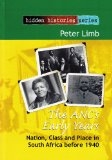|
Reviewed by: Myra Houser, Ph.D. Candidate, Howard University Peter Limb’s The ANC’s Early Years traces the organization’s history prior to 1940, using biographies and other writings on early figures and fitting them into the framework that theorists on nationalism have developed. Although Limb claims his book has no central hypothesis (492), his essential aim is to show that the present-day African National Congress developed from a similar organization, and that the group’s current role as leader of the tripartite alliance that includes the Communist Party of South Africa (CPSA) and Congress of South African Trade Unions (COSATU) grew out of early relationships with CPSA and COSATU’s predecessor, the Industrial and Commercial Workers’ Union (ICU). Additionally, Limb cites myriad examples of early ANC work with workers in an attempt to quiet criticisms that the group has always been comprised of educated and middle-to-upper class members. Limb’s early discussions linking the ANC to nationalist theories, particularly on pages 24-25, appear modeled after those of mid-twentieth-century Africanists, who spoke of Africa in relation to Euro-centric frameworks, thus attempting to bring the continent into a wider discussion on history. In Limb’s case, he argues that the ANC should be considered nationalist, although it works across ethnic groups, primarily because its leaders believe in the structure of nations and try to work within that structure’s system (8). The discussion on nationalism should have its intended effect. Although historians of South Africa will seem a most natural audience for this work, theorists interested in comparative nationalism, as well as students seeking to learn more about organizational structure, may also find it useful. In addition to serving as a nationalist group, Limb argues that the ANC grew and found relevance with lower-class workers primarily because of its role as a stand-in for unions (41) and thrived because it was not an elite organization (103). In early twentieth-century South Africa, where labor organizing became heavily controlled and politically dangerous for mine, farm, and manufacturing workers, Limb argues that the ANC stepped in as an intermediary that petitioned before employers on behalf of their workers. Thus, working-class Africans could find an advocate with an organization that, since it carried no trade union label, may have enjoyed a more receptive audience among labor bosses. Although Limb claims in the work’s preface that he has not adopted the exceptionalist lens through which many observers of South Africa’s freedom struggle view the ANC, he does argue that the organization became the only one receptive to workers’ needs. On page 237, for example, he claims that the CPSA and ICU, both contain members from primarily upper and middle classes, although both groups claim to speak on behalf of lower-class workers. Limb himself, however, fails to show that the ANC was any more integrated in this respect, as most of his narratives contain examples of the ANC reaching down to recruit lower class workers, rather than these workers reaching up to influence the ANC—one of the primary points he desires to argue. Thus, in this aspect, the book does not quite succeed in proving Limb’s claim that the ANC was a grassroots movement from its inception. Additionally, Limb has attempted with some success to insert women into the discussion. Despite the ANC’s ban on female members during its early years, the group showed concern for women’s issues such as pass laws, against which it engaged in demonstrations (316). Much like his attempts to portray the ANC as a grassroots organization, however, Limb does not totally succeed in demonstrating that women formed an integral, although unofficial part of the ANC. Many of his discussions on the subject seem to follow an “add women and stir” approach, where he inserts a female-oriented story awkwardly at the end of chapters. Perhaps a more full integration of women into the overall narrative, rather than a few passages mentioning their presence would have done more to argue for their importance. Despite these shortcomings, Limb has written an important work. The ANC’s Early Years certainly contrasts with Peter Walshe’s seminal book, The Rise of Nationalism in South Africa (UCLA Press, 1971), which advances a romanticized view of the ANC’s development while ignoring its relationships with other political parties and workers’ organizations. Additionally, The ANC’s Early Years is simple to read and logically divided into a section of chapters representing each decade, making it easy for instructors to pick apart and assign in sections. Read as a whole, the work presents a detailed and well-researched view of the early ANC, although individual chapters can stand alone to introduce those unfamiliar with South African history to issues within the country’s, and ANC’s development. |


 The ANC’s Early Years: Nation, Class and Place in South Africa Before 1940
The ANC’s Early Years: Nation, Class and Place in South Africa Before 1940